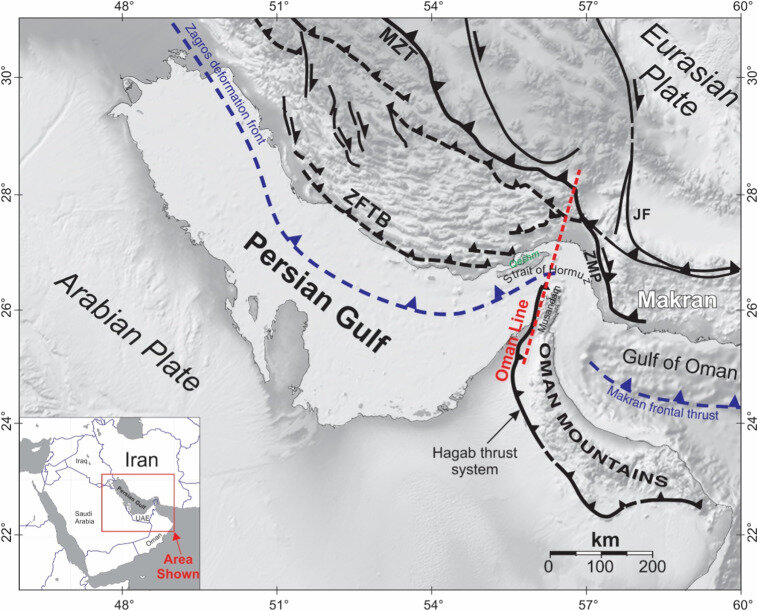Tehran – Seven earthquakes of 4-5 sizes at the Southern Persian Gulf and Saudi Arabian Qatar border from March 1 to May 5, 2025 probably represent the link between hydrocarbon extraction and earthquakes.
Hydrocarbon extraction for oil and gas production can alter underground stress fields and reactivate obstacles.
The Arabian plate experienced significant seismic activity between 2024 and 2025 and was affected by structural interactions with Eurasia, Africa (Nubia) and Indian plates.
The Arabian plate travels northeast (approximately 1.5-2 cm/yr), collides with Eurasia, forming the Zagros Mountains, and glides westward along the Dead Sea Transistor (DST) through the African plates.
Subduction occurs under the Macran Mountains (south Iran/Pakistan) and opens in the Red Sea and Gulf of Aden.
Deep faults in crystalline subterranean rocks (in Arabic plates) are sensitive to changes in stress. This area is located on the Arabian plates and contains underground faults associated with the Zagros orogeny and the lifting of the Red Sea.
The Gowar Hydrocarbon Field (Saudi Arabia) and Shemalgas Field (Qatar) are one of the largest hydrocarbon reservoirs in the world. Some of the faults in this region are highly emphasized. This means that even small changes in pressure can cause slips.
Seven earthquakes between March and April 2025 destabilize adjacent faults (e.g. due to increased production/infusion due to increased extraction or wastewater treatment (e.g. due to increased destruction or oil recovery).
If the operation occurs near a slip strip or reverse fault, stress transfer can cause moderate earthquakes (M4-M6). Sometimes induced earthquakes occur months or years after the start of surgery due to gradual changes in stress.
Although there are no major documented cases of moderate seismic induced seismic activity reported in Saudi Arabia/Qatar, there is a risk of seismic activity being induced if exploration and extraction surgery interrupts the impairment.
Mild to Medium Earthquakes (M3-M5): Can damage infrastructure, pipelines, or offshore platforms. Major earthquakes (M6+): This is possible when major bedrock obstacles reactivate and pose risks to cities such as Dammam and Doha.
The Saudi-Qatar region has not yet experienced a major earthquake, but the combination of aggressive underground faults and intense hydrocarbon activity increases this risk. The March-April 2025 event was plausible for production/ejection surgery to disrupt a serious stress disorder. Monitoring and risk assessment are important to prevent such scenarios.
The structural seismic frameworks of East Saudi Arabia, Qatar and Bahrain are primarily characterized by the complex interactions between Arabic plates and complex tectonic plates with surrounding Eurasian and African plates. The region experiences seismic activity due to its geological location, including major fault systems and oil and gas production activities.
The East Saudi Arabia region, including Qatar and Bahrain, is along the Arabian plate boundary. The Arabian plates are moving north relative to the Iranian and Eurasian plates at a speed of about 20 mm/yr. This movement provides compressive forces that generate seismic activity in the area.
The area is cut by critical fault systems, such as the Dead Sea Crossing Fault on the western border to the north and various slip-off faults associated with the Zagros Mountains to the northeast. These faults correspond to movement between plates. Earthquakes in this region can be attributed to both natural structural processes and anthropogenic factors associated with oil extraction activity.
The area is characterized by several important geological features, including active underground faults that play an important role in the structural and seismic behavior of the area.
Several small faults have been identified in eastern Saudi Arabia. The Al Hasa Fault is located near the Al Hasa Oasis and is associated with a historic seismic event.
The Qatif fault near the Qatif shows signs of activity and can affect local earthquakes. Qatari Ark is a structure that influences Qatar’s underground geology. The formation of this structural arc, part of the larger Qatar Keizan underground structure, results in local stress concentrations along existing faults.
The accumulation of stress along these faults often leads to earthquakes in clusters or sequences. Historical records show that major earthquakes are relatively rare, but less tremors due to ongoing structural processes.
Historical data show that earthquakes in this region often occur in clusters or sequences rather than isolated events, indicating complex interactions between local geological structures.
Hydrocarbon extraction in eastern Saudi Arabia is associated with induced seismicity.
The oil extraction process can lead to changes in underground pressure conditions, causing and potentially causing small earthquakes. Seismic events have been recorded near major oil fields such as Ghawar, where liquid extraction can affect local stress conditions.
Saudi Arabia’s geological survey and Iran’s seismic network are actively monitoring seismic activity in oil-producing regions. Data from these surveillance activities show a correlation between periods of intense hydrocarbon extraction and increased seismic events. Earthquakes in this zone raise concerns about the safety of the infrastructure and the long-term sustainability of oil production practices in this seismic region.
The structural structures of East Saudi Arabia, Qatar and Bahrain are shaped by complex plate interactions that lead to important seismic activity driven by natural structural processes and anthropogenic factors resulting from oil and gas production. Continuous monitoring is essential to understand these dynamics and to mitigate the risks associated with earthquake hazards in this economically important area.

